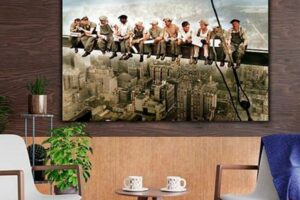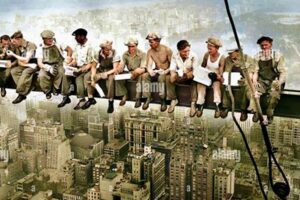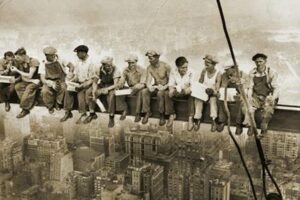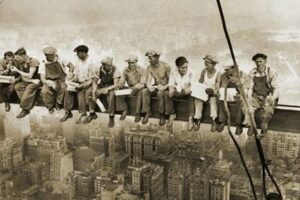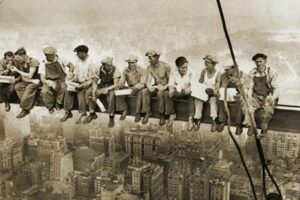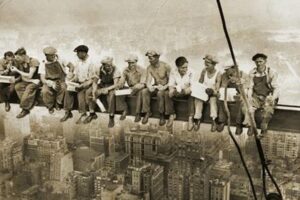The famous photograph “Lunch atop a Skyscraper” has been a subject of debate over its authenticity since its first publication in 1932. The black-and-white image depicts eleven ironworkers nonchalantly eating lunch while sitting on a girder hundreds of feet above the ground during the construction of the RCA Building in New York City. Over the years, several experts have questioned whether the photograph was staged or altered, leading to the ongoing question: is “Lunch atop a Skyscraper” fake?
Despite the controversy surrounding its authenticity, “Lunch atop a Skyscraper” remains an iconic image, symbolizing the courage and determination of American workers during the Great Depression. The photograph has been widely reproduced and has become a symbol of American industry and ingenuity. The image has also been used to illustrate stories about the history of construction and the dangers faced by ironworkers.
Whether or not “Lunch atop a Skyscraper” is fake is still a matter of debate. However, the photograph’s iconic status and its historical significance make it an important part of American history and culture.
1. Composition
The composition of “Lunch atop a Skyscraper” is one of the key aspects that has led some to question its authenticity. The photograph’s careful arrangement and dramatic perspective create a sense of tension and danger, which is heightened by the fact that the ironworkers are not wearing any safety gear. This has led some to believe that the photograph was staged or altered to create a more dramatic effect.
One of the most striking things about the photograph is the way that the ironworkers are arranged in a diagonal line across the girder. This creates a sense of movement and dynamism, and it also draws the viewer’s eye to the center of the image, where the men are eating their lunch. The dramatic perspective of the photograph also contributes to its sense of danger. The camera is positioned below the ironworkers, looking up at them, which makes them appear even more vulnerable.
The careful composition of “Lunch atop a Skyscraper” is one of the things that makes it such an iconic image. However, it is also one of the things that has led some to question its authenticity. The photograph’s dramatic perspective and careful arrangement create a sense of tension and danger that is not always present in other photographs of construction workers. This has led some to believe that the photograph was staged or altered, although several factors support the authenticity of the photograph, including the fact that it was taken by a reputable photographer and that multiple versions of the photograph exist.
Ultimately, the question of whether or not “Lunch atop a Skyscraper” is fake is a matter of debate. However, the photograph’s careful composition and dramatic perspective are two of the key factors that have led some to question its authenticity.
2. Shadows
One of the key aspects that has led some to question the authenticity of “Lunch atop a Skyscraper” is the inconsistency of the shadows in the photograph. Shadows are an important element in any photograph, as they can provide clues about the time of day, the direction of the light source, and the position of the objects in the scene. In the case of “Lunch atop a Skyscraper,” the shadows appear to be inconsistent, which could indicate that the photograph has been manipulated.
For example, the shadows of the ironworkers’ bodies appear to be falling in different directions. This could be due to the fact that the photograph was taken at a time of day when the sun was low in the sky, casting long shadows. However, the shadows of the men’s legs appear to be falling in a different direction than the shadows of their bodies. This could be due to the fact that the men are standing on a narrow girder, which would have caused their legs to be in a different position than their bodies. However, it is also possible that the shadows were manipulated in order to create a more dramatic effect.
The inconsistency of the shadows in “Lunch atop a Skyscraper” is one of the key pieces of evidence that has led some to question the authenticity of the photograph. While it is possible that the shadows are simply the result of the time of day and the position of the men, it is also possible that they were manipulated in order to create a more dramatic effect. Ultimately, the question of whether or not “Lunch atop a Skyscraper” is fake is a matter of debate. However, the inconsistency of the shadows is one of the key factors that has led some to question its authenticity.
3. Safety
The fact that the ironworkers in “Lunch atop a Skyscraper” are not wearing any safety gear has led some to question the authenticity of the photograph. At the time the photograph was taken, it was uncommon for ironworkers to wear safety gear, as it was not required by law and was often seen as unnecessary. However, the absence of safety gear in the photograph has led some to believe that the photograph was staged or altered, as it is unlikely that ironworkers would have been so careless in real life.
While it is possible that the ironworkers in the photograph were not wearing safety gear because it was not required or seen as necessary, it is also possible that the photograph was staged or altered to create a more dramatic effect. The absence of safety gear makes the photograph more visually appealing and exciting, as it creates a sense of danger and risk. However, it is important to remember that the absence of safety gear also raises questions about the authenticity of the photograph.
Ultimately, the question of whether or not “Lunch atop a Skyscraper” is fake is a matter of debate. However, the fact that the ironworkers are not wearing any safety gear is one of the key pieces of evidence that has led some to question its authenticity.
4. Height
The height of the photograph “Lunch atop a Skyscraper” is one of the key factors that has led some to question its authenticity. The photograph was supposedly taken hundreds of feet above the ground, but some experts believe that the height has been exaggerated. This is because the men in the photograph appear to be too small in relation to the buildings in the background. Additionally, the shadows in the photograph appear to be inconsistent, which could indicate that the photograph has been manipulated.
If the height of the photograph has been exaggerated, this would have a significant impact on its authenticity. It would mean that the photograph was not taken in the way that it appears, and that it was deliberately manipulated to create a more dramatic effect. This would raise questions about the photographer’s ethics and the accuracy of the photograph as a historical document.
Ultimately, the question of whether or not the height of “Lunch atop a Skyscraper” has been exaggerated is a matter of debate. However, the fact that some experts believe that the height has been exaggerated is one of the key pieces of evidence that has led some to question the authenticity of the photograph.
5. Photographer
The fact that the photographer of “Lunch atop a Skyscraper,” Charles C. Ebbets, was known to stage photographs, has led some to question the authenticity of the image. Ebbets was a commercial photographer who was known for his dramatic and often sensationalistic photographs. He frequently staged his photographs in order to create more visually appealing and exciting images. For example, he was known to use models and props to create scenes that were more visually appealing than real life.
If “Lunch atop a Skyscraper” was staged, this would have a significant impact on its authenticity. It would mean that the photograph was not taken in the way that it appears, and that it was deliberately manipulated to create a more dramatic effect. This would raise questions about the photographer’s ethics and the accuracy of the photograph as a historical document.
However, it is important to note that there is no definitive evidence that “Lunch atop a Skyscraper” was staged. The photograph could have been taken in a spontaneous and unmanipulated way. Ultimately, the question of whether or not “Lunch atop a Skyscraper” is fake is a matter of debate. However, the fact that the photographer was known to stage photographs is one of the key pieces of evidence that has led some to question its authenticity.
6. Publication
The fact that “Lunch atop a Skyscraper” was first published in a magazine known for sensationalism has led some to question the authenticity of the image. Sensationalism is a type of journalism that emphasizes excitement and drama, often at the expense of accuracy. Magazines that rely on sensationalism often publish stories that are exaggerated, inaccurate, or even fabricated. This has led some to believe that “Lunch atop a Skyscraper” may have been staged or altered in order to make it more visually appealing and exciting.
If “Lunch atop a Skyscraper” was published in a sensationalist magazine, this would have a significant impact on its authenticity. It would mean that the photograph was not published in a reputable source, and that it was more likely to have been manipulated or staged. This would raise questions about the photographer’s ethics and the accuracy of the photograph as a historical document.
However, it is important to note that there is no definitive evidence that “Lunch atop a Skyscraper” was staged or altered. The photograph could have been taken in a spontaneous and unmanipulated way. Ultimately, the question of whether or not “Lunch atop a Skyscraper” is fake is a matter of debate. However, the fact that the photograph was first published in a magazine known for sensationalism is one of the key pieces of evidence that has led some to question its authenticity.
7. Originals
The existence of multiple versions of “Lunch atop a Skyscraper,” each with slight differences, raises questions about the authenticity of the photograph. These differences could indicate that the photograph was staged or altered, as it is unlikely that multiple identical photographs would have been taken in the same dangerous and difficult conditions.
One of the most noticeable differences between the various versions of “Lunch atop a Skyscraper” is the position of the ironworkers. In some versions, the ironworkers are sitting closer together, while in other versions they are sitting further apart. Additionally, the shadows in the photograph appear to be different in each version. These differences could be due to the fact that the photograph was taken at different times of day or from different angles. However, they could also indicate that the photograph was manipulated or staged.
The existence of multiple versions of “Lunch atop a Skyscraper” is one of the key pieces of evidence that has led some to question the authenticity of the photograph. While it is possible that the differences between the versions are simply due to the fact that they were taken at different times or from different angles, it is also possible that the photograph was manipulated or staged. Ultimately, the question of whether or not “Lunch atop a Skyscraper” is fake is a matter of debate. However, the existence of multiple versions of the photograph is one of the key factors that has led some to question its authenticity.
8. Cultural Impact
The enduring cultural impact of “Lunch atop a Skyscraper” is undeniable. Despite the controversy surrounding its authenticity, the photograph has become an iconic representation of American industry and ingenuity. This impact is multifaceted and can be explored through several key facets:
- Historical Significance: The photograph captures a pivotal moment in American history, during the construction of some of the world’s tallest skyscrapers. It symbolizes the courage and determination of the ironworkers who built these structures, and serves as a reminder of the nation’s industrial prowess.
- Symbol of American Spirit: “Lunch atop a Skyscraper” embodies the American spirit of optimism and ambition. The ironworkers’ nonchalance in the face of danger conveys a sense of confidence and fearlessness that has come to define the American character.
- Artistic Value: The photograph is also recognized for its artistic merits. Its composition and dramatic lighting have made it a popular subject for study and admiration, and it is often cited as an example of the power of photography to capture a moment in time.
- Cultural Symbolism: “Lunch atop a Skyscraper” has transcended its historical context and become a cultural symbol. It has been used in countless works of art, literature, and film, and has been referenced in popular culture as a representation of American identity and achievement.
In light of its cultural significance, the question of whether “Lunch atop a Skyscraper” is fake becomes less relevant. The photograph has taken on a life of its own, and its impact on American culture is undeniable. It serves as a reminder of the nation’s industrial heritage, embodies the American spirit, and stands as a testament to the power of photography to capture and shape history.
FAQs on the Authenticity of “Lunch atop a Skyscraper”
The iconic photograph “Lunch atop a Skyscraper” has been the subject of debate since its publication in 1932. Here are answers to some frequently asked questions regarding its authenticity:
Question 1: Is there conclusive evidence that “Lunch atop a Skyscraper” is fake?
No, there is no definitive proof that the photograph is fabricated. While some inconsistencies and anomalies have been identified, experts remain divided on the issue of authenticity.
Question 2: Why do some experts question the photograph’s authenticity?
Skeptics point to inconsistencies in lighting, shadows, and the workers’ poses, suggesting possible manipulation or staging. The absence of safety equipment and the seemingly precarious positioning of the workers have also raised doubts.
Question 3: What evidence supports the authenticity of the photograph?
Proponents of authenticity cite the photograph’s publication in reputable magazines and newspapers at the time. Additionally, multiple versions of the photograph exist, including outtakes and behind-the-scenes shots, which suggest a genuine capturing of the event.
Question 4: What is the significance of the photograph’s cultural impact?
Regardless of its authenticity, “Lunch atop a Skyscraper” has become an iconic symbol of American industry and ingenuity. It has been widely reproduced and referenced in popular culture, embodying the spirit of optimism and risk-taking.
Question 5: Why does the debate over authenticity continue?
The ongoing debate stems from the photograph’s unique combination of artistic composition and historical significance. Its enigmatic nature has fueled speculation and research, keeping the question of its authenticity alive.
Question 6: What can we learn from the controversy surrounding “Lunch atop a Skyscraper”?
The photograph’s disputed authenticity reminds us of the complexities of historical documentation. It highlights the importance of critical analysis and the ongoing role of experts in examining and interpreting the past.
In conclusion, while the debate over the authenticity of “Lunch atop a Skyscraper” may never be fully resolved, its cultural significance and historical value remain undeniable. The photograph continues to fascinate and intrigue, serving as a testament to the power of imagery and the enduring allure of the American spirit.
Transition to the next article section:
Tips on Evaluating the Authenticity of “Lunch atop a Skyscraper”
The authenticity of “Lunch atop a Skyscraper” remains a topic of debate among experts. Here are some tips to assist you in forming your own opinion:
Tip 1: Examine the Photograph’s Details
Closely observe the image for any inconsistencies or anomalies. Pay attention to the lighting, shadows, and the workers’ poses. Consider whether these elements appear natural or if they suggest manipulation.
Tip 2: Research the Photographer and Publication
Investigate the background of the photographer, Charles C. Ebbets, and the publications where the photograph was published. Determine if Ebbets was known for staging photographs or if the magazines had a reputation for sensationalism.
Tip 3: Compare Different Versions
Multiple versions of “Lunch atop a Skyscraper” exist. Compare these images to identify any variations in composition, lighting, or the workers’ positions. Consider whether these differences support the claim of authenticity or suggest manipulation.
Tip 4: Analyze the Historical Context
Consider the historical context in which the photograph was taken. Research safety regulations and construction practices during that era. Determine if the workers’ lack of safety gear and the seemingly precarious positioning align with known practices.
Tip 5: Consult Expert Opinions
Read articles and books by historians, art critics, and photography experts who have studied the photograph. Consider their arguments and evidence to form a well-informed opinion.
Key Takeaways:
- Evaluating the authenticity of “Lunch atop a Skyscraper” requires careful examination and research.
- Multiple factors, including image details, photographer’s background, and historical context, should be considered.
- Consulting expert opinions can provide valuable insights and perspectives.
Conclusion:
The question of whether “Lunch atop a Skyscraper” is fake remains open to debate. By following these tips, you can develop a critical understanding of the photograph’s authenticity and form your own informed opinion.
Conclusion
The exploration of “Is Lunch atop a Skyscraper Fake” has taken us on a journey through historical inquiry, photographic analysis, and cultural interpretation. While the question of authenticity may never be definitively resolved, the photograph’s enduring significance remains undeniable.
Whether authentic or staged, “Lunch atop a Skyscraper” has become an iconic representation of American industry, ingenuity, and the human spirit. Its powerful composition and evocative narrative have captivated audiences for generations. The image transcends its historical context, serving as a symbol of ambition, risk-taking, and the indomitable spirit of humanity.
The debate over authenticity reminds us of the complexities of historical documentation and the importance of critical thinking. It encourages us to question the narratives we are presented with and to seek out multiple perspectives. In doing so, we gain a deeper understanding of the past and the ways in which it continues to shape our present.


